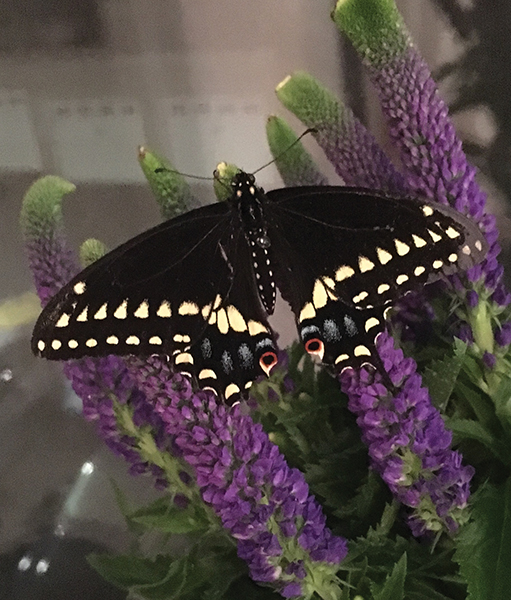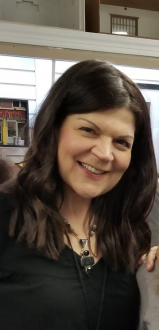Signs of nature, life and art inhabit every corner of Olga Sweet’s light-filled New Canaan condo.
During a recent visit on an unseasonably mild February day, she tells me that this is a “temporary” home for the family, and yet, it appears anything but transitory. The open space exudes the lived-in vibe of its inhabitants — Olga, husband Robert, sons James, 19, away at college, and William, 11. Two fish, two parakeets (Dom and Perignon), a cat (Octavia) and lastly, three chrysalises not in plain sight — future butterflies protected in their hard-shelled pupas — round out the mix. These three have been in occupancy over the winter (two attached to a piece of bark and one under the frame of a sliding door), awaiting the opportunity to emerge this spring as beautiful Swallowtail butterflies. But let’s not get ahead of ourselves.

Back in November of last year, WAG first visited Olga to view her paintings and discuss her artistic talents and success in creating many commissioned and noncommissioned works of art — for clients and nonprofits, to which she has donated dozens of works for charity auctions. This month, she will contribute a portrait to the American Red Cross Metro NY North Red & White Ball — marking the third year in a row she has done so. More portraits are scheduled to be auctioned this spring, summer and fall at the Princess Grace Foundation-USA gala, the Chicago Heart Ball, the Leukemia & Lymphoma Society in Washington, D.C.’s gala, the UNICEF Gala, the CTREE (Center for Therapeutic Riding of the East End) gala in the Hamptons and other benefits.
Today, Olga proudly produces an original letter she received in late November on Buckingham Palace stationery. It is signed by a social secretary of Queen Elizabeth II, acknowledging the receipt of a letter sent by Olga together with a photograph of a painting she had done of the monarch. Her Majesty has suggested that Olga consider donating the piece to the British Red Cross. This recognition and her own brush with royalty is humbling to her.
As to the Monarchs of the butterfly variety, there is a “sweet” story Olga relates of how she and her younger son came to raise them. Last summer the family lost its beloved pet rabbit, Lord Marmaduke Chumwell, or Chuffy, after 11½ years, longer than the entirety of William’s young life. Together they found solace on the grounds of the New Canaan Nature Center, a special place they often visited and where both have volunteered. Staff members there pointed out some varieties of caterpillars, resting and munching on milkweed leaves and suggested they may want to experience raising these creatures in their own home environment.
Extensive research quickly ensued, and, over the course of months, they raised nearly 50 butterflies, the majority set free to live their lives outdoors. Including the time spent eating, mating and laying the eggs of the next generation, their lifespan is just seven to 10 days on average. There are scores, however, of late-season bloomers who follow the wind, scent and warm temperatures, traveling thousands of miles to migrate to softer climates in Southern California or Mexico’s famed Oyamel Fir Forest, a high-elevation mountain range, home to millions of the monarch variety every winter. My own research leads to a children’s book of poems about butterflies. The author, Avis Harley, writes “There are no borders for the migrating monarch. It is all one land.”
Olga has a dog-eared copy of the book “Monarchs and Milkweed” by Anurag Agrawal (Princeton University Press, 2017) perched on her living room sofa. Clearly, it’s been referenced frequently as she and William strove to raise these butterflies to exacting standards. Diet, habitat and managing the household cat (she’s fine with them, by the way) were all carefully considered.
Olga and William supplied the vital milkweed plant, but daily runs to Whole Foods became necessary for other life-sustaining, nectar-rich floral stems, particularly as the weather started turning toward fall and outdoor nutrients were diminishing. After their successes with the colorful Monarchs, they moved on to the stunning swallowtail variety.
Butterflies exert tremendous effort as they pass through the four stages of life before becoming the beauties we admire — from an egg to a larva (caterpillar) to a hard-shelled pupa from which they emerge finally as adults, most often early on a warm, sunny morning. The molting process, or the metamorphosis, witnessed and captured on film and video by Olga and William over and over, has carried with it important life lessons for her son, she tells me.
According to Olga, this story is about “trying to create a good citizen.” She wanted William to see nature as a force to be respected, much like a woman, especially “in this culture of male dominance.” In this case, by raising a species that comes in second only to bees as the leading pollinators on our planet, Olga says, “I don’t think my son could ever hurt a living creature. If you have instilled an empathy for a living thing, if you have taught the life lessons of patience, caring and the fragility of life, then the world truly will be a better place for others.”
For more, visit olgasweet.com and newcanaannature.org.


